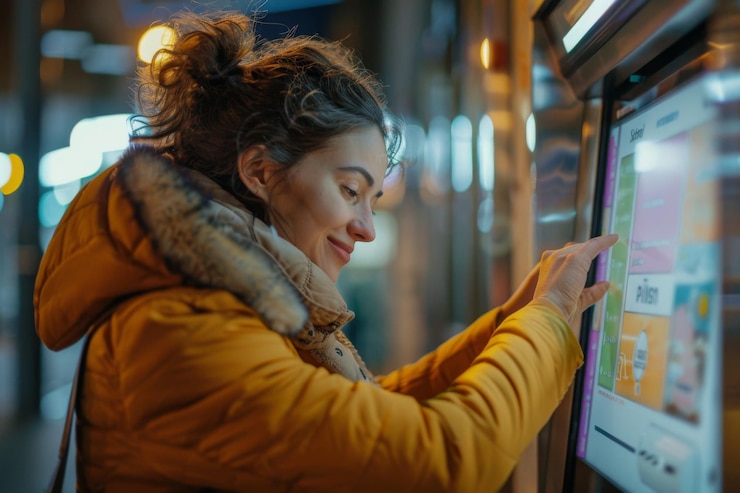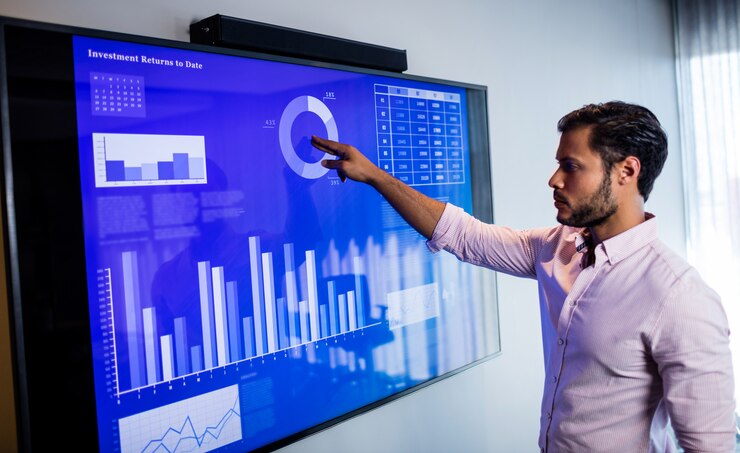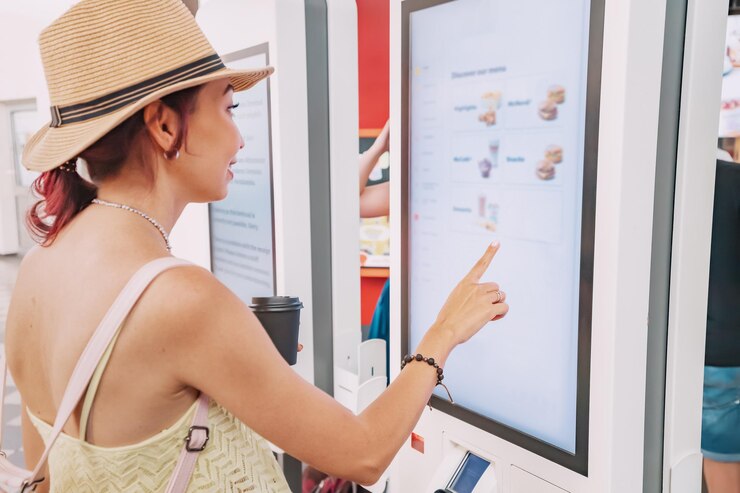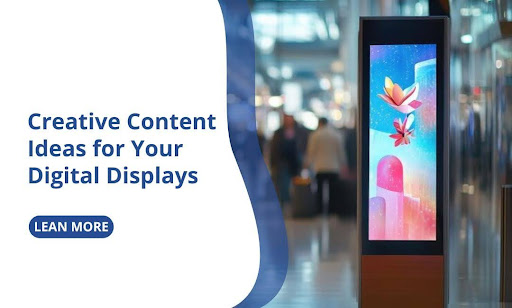Screens don’t sell. Content does. You could have the brightest display in the city, but if the content falls flat, people will walk right past it. No eye contact. No reaction. No results. That’s the trap most businesses fall into. They put the digital screens up, then run the same old loop. Static promotions. Generic slides. Maybe a weather widget thrown in for good measure.
Here’s the truth no one likes to say out loud: Digital signage displays aren’t impressive by default. They’re only effective if the content on them earns attention. Otherwise, they’re background noise.
This article strips away the guesswork. It breaks the content wall down and gives you real, actionable ideas you can start using today. Not vague concepts. Not trendy fluff. Actual screen content that turns heads and moves people to act.
Here’s what we’re about to break down:
- Time-sensitive promos that ride trends and drive urgency
- Social proof loops that build trust in seconds
- Live stats and counters that nudge behavior in the moment
- Localized content that matches the vibe of the space
- Interactive hooks that pull viewers into the screen
Each of these ideas has one thing in common: they don’t waste screen space. They fill it with content that grabs attention and gives it somewhere to go. Keep reading. Your screens are about to work harder.
Make Every Second Count with Time-Sensitive Promos
If your content doesn’t move fast, neither will your audience. The window to grab attention is short, often under five seconds, according to research. And that’s not five seconds to tell a whole story. That’s five seconds to spark interest, pull focus, and push someone closer to a decision.
That’s where time-sensitive promos come in. They create urgency. They match the rhythm of your viewers’ day. And they turn your screens into triggers, not placeholders.
Why Time-Sensitive Content Outperforms Passive Loops
Looping promotions can feel invisible after a few passes. Your audience learns to tune them out. But promos tied to limited-time deals, trending products, or countdowns cut through. They bring urgency into play and press decision-making forward.
Here’s how you push that urgency into motion:
- Flash sales that expire by the hour or the day
- Daily menus or offers that rotate on a set schedule
- Live countdowns tied to events, discounts, or capacity (e.g., “4 spots left”)
- Seasonal product drops that lean on scarcity
- Price fluctuations that reflect supply or demand shifts in real-time feeds
Each one shortens the decision path. And none of them rely on loud design or gimmicks — they hinge on timing, context, and smart scheduling.
Let Social Proof Do the Heavy Lifting

You can write the sharpest sales copy on screen — but if it’s you saying it, people filter it out. Trust doesn’t come from bold headlines. It comes from seeing someone else take the leap first. That’s the power of social proof, and when you build it into a screen loop, it works without any extra effort from your staff.
What a Social Proof Loop Looks Like on Screen
This isn’t about tossing a few star ratings on the bottom corner of a layout. A well-structured loop cycles through validation. It shows viewers that real people are buying, signing up, checking in, or leaving feedback — right now.
Here are a few examples that work:
- Live check-in boards showing names or counts of customers entering your space
- Customer spotlight slides with a name, photo, and quick quote
- Rolling review snippets from platforms like Google or Yelp
- Testimonials from repeat clients tied to specific services or outcomes
- User-generated content walls from branded hashtags or mentions
This type of content doesn’t just fill space. It creates micro-moments of confirmation. Each one makes the next viewer feel like they’re making the right call, not because they were convinced, but because someone else already was.
Why This Works on a Loop
The value comes from frequency and freshness. A static testimonial is better than nothing, but rotating endorsements land stronger when the feed shifts every few seconds. Done right, it creates the effect of activity and motion — the exact opposite of an empty store or flat promotion.
And if the message on-screen shows that others trust you, that message sticks long after the viewer walks away.
Use Live Stats to Push Action Forward

People move when the numbers move. That’s the core idea behind screens that display live stats and counters. They don’t wait for viewers to guess. They push a number up or down and let that movement shape decisions on the spot.
It’s behavioral psychology at work — and it’s quietly effective.
What You Can Count (And Why It Works)
A live stat isn’t a decoration — it’s a behavioral trigger. When placed correctly, a data feed can reduce hesitation, fuel urgency, and sharpen decision-making at the point of interaction.
But not all numbers work equally well. The best ones meet three criteria:
- They’re tied to limited access or scarcity.
- They move often enough to be noticed.
- They create a binary reaction: act now or miss out.
Let’s break that down with real use cases:
- Seat Availability: Gyms, co-working spaces, or training facilities can show how many seats are left in a session. A live counter — updated as people reserve — pressures onlookers to commit before the last spot disappears. You’re not telling them to act. You’re showing them that others already are.
- Inventory Counters: In retail, stock levels for limited runs or popular SKUs can be pulled from inventory systems and surfaced on screens. Showing “12 units left” drives faster purchasing than a generic “now available” message. It makes each remaining item count.
- Live Customer Count: Restaurants, fitness clubs, or service lounges can show how busy the space is. For quieter times, that stat becomes an incentive to come in. For peak times, it helps manage expectations and push mobile or online alternatives.
- Order Velocity: Fast-moving counters like “X orders placed today” signal social momentum. The more the number climbs, the more it validates the product’s demand, while subtly urging others not to fall behind.
- Progress-Based Goals: Showing progress bars for group goals (e.g., “84% of today’s donation goal met”) helps activate contributions. These are especially effective in nonprofit, education, or community environments where collective effort drives action.
Technical Considerations
To make these counters meaningful — and accurate — your screen system needs to pull data from reliable sources and update automatically. That requires:
- APIs or webhook integrations with your POS, booking, CRM, or inventory software
- Scheduled data pulls or push triggers depending on latency tolerance
- On-screen widgets are built to refresh without user input
- Fallback states in case of connection failure (e.g., frozen count with timestamp)
If the counter isn’t fresh, it loses credibility fast. And once that trust breaks, the screen becomes noise instead of signal.
This is where the design, placement, and timing of your stat matter more than the content around it. A single number, updated at the right moment, can outperform an entire promotional video loop — because it’s relevant, immediate, and impossible to ignore.
Match the Message to the Environment
A display should feel like it belongs where it stands. That doesn’t happen by looping the same content across every screen. It happens when the message aligns with the purpose of the space, the timing of the moment, and the behavior you want to guide.
Localized content isn’t a nice-to-have. It’s a requirement if you want the screen to pull focus instead of blend in.
What Localized Content Actually Means
It’s not about putting the city name in a header. Localized content responds to the specific context of the location, physically, socially, and operationally. Each space comes with its own expectations and use cases. The content has to speak to that.
Here’s how it plays out across different environments:
Retail Stores
In retail, content should shift with store layout, product placement, and foot traffic flow.
Examples:
- Promotional screens near the point-of-sale push upsells
- Screens near fitting rooms promote accessories or bundles
- End-cap displays rotate featured items or limited runs
- Entrance screens greet visitors with local events or in-store exclusives
Hospitality Venues
Hotels, resorts, and lounges serve guests who expect service and simplicity. Content here should answer unspoken questions.
Examples:
- Lobby screens show check-in times, events, or restaurant hours
- Wayfinding content helps guests locate amenities
- Poolside or bar displays highlight current specials
- QR codes for room service menus or spa bookings
Medical Facilities
In healthcare, anxiety is high, and time is tight. The content needs to be calm, clear, and helpful.
Examples:
- Waiting area screens show queue progress or appointment prep info
- Pharmacy counters push reminders for medication pickup
- Pediatric zones loop child-friendly distractions
- On-screen messages reinforce safety protocols without pressure
Educational Environments
Schools, colleges, and training centers use signage for both administration and engagement.
Examples:
- Campus-wide alerts push emergency updates
- Hallway screens list room changes or professor availability
- Dining halls rotate menus with allergen callouts
- Digital bulletin boards highlight student events, deadlines, or club announcements
Stadiums and Arenas
High volume, fast movement. Every second matters.
Examples:
- Entryway screens streamline gate instructions
- Concession stands update pricing or estimated wait times
- Game-day stats or fan leaderboards rotate between plays
- Post-event traffic guidance shows transit routes or parking status
Shopping Malls
You’re guiding movement and holding attention in large, open areas.
Examples:
- Directory screens near entrances use smart mapping
- Event-based content promotes mall-wide activities
- Offers from nearby stores rotate based on proximity
- Targeted promotions adjust by time of day (e.g., food court lunch deals)
Roadside and Transit Spaces
Billboards, bus terminals, and metro platforms demand fast reads and precise timing.
Examples:
- Traffic updates and ETA boards reduce commuter uncertainty
- Government messaging pushes public campaigns or compliance reminders
- Weather triggers adjust the digital signage content for safety alerts or travel warnings
- Short, high-contrast designs push local events, toll info, or alerts
Government and Civic Buildings
These digital signage screens must deliver clarity over creativity.
Examples:
- Directional signage manages queues and document submission steps
- ID or appointment verification procedures are in place at intake points
- Lobby content sets the tone with updates, notices, or rights information
- Case status screens update wait times without disclosing private data
One message won’t serve every screen. Matching the message to the moment, the space, and the people in it is how digital signage stops being noise and starts pulling its weight.
Get People to Act with Interactive Hooks

Screens don’t have to be passive. The moment you let people tap, scan, speak, or submit, you’ve turned a one-way display into a two-way decision tool. That’s what makes dynamic digital signage content valuable. It doesn’t ask for attention. It pulls it in and holds it long enough to shape the next move.
And in most cases, it takes less effort than you’d expect.
Where Interactive Content Belongs
Not every screen should be interactive. However, high-density areas, customer service zones, and transactional touchpoints are prime real estate for it.
Examples include:
- Touchscreen directories in malls, airports, and campuses
- QR-triggered promotions in retail, hospitality, and events
- SMS or short link sign-ups tied to loyalty programs or feedback forms
- Voice-controlled kiosks in medical or high-traffic settings
- Live polls or voting displays in corporate or entertainment environments
- Event-driven displays that double as a social wall for real-time hashtag feeds
These don’t overwhelm the viewer. They give them one clear path — take an action, get a result — without needing staff to intervene.
What Makes the Hook Work
The interaction must be clear, immediate, and rewarding. If the instructions aren’t obvious or the result isn’t worth it, people will walk past the opportunity. That’s why the strongest hooks use these principles:
- Low friction: No long forms. No clunky processes. Just tap, scan, or speak.
- Visible feedback: Show something changed or updated once someone interacts.
- Real benefit: Deliver a coupon, shortcut, or acknowledgment that makes the input feel worth it.
Example: A food court screen that lets customers vote on tomorrow’s featured dish, then displays a live tally, and gives voters a coupon. That’s an interaction with a purpose.
When you utilize digital signage in this way, you stop broadcasting and start engaging.
Digital signage screens help businesses move from passive displays to active touchpoints. And with well-placed digital signs, you can guide people through the next step, without ever saying a word.
Creative Display Content Made Simple with Smart Strategy
Good content isn’t complicated — it’s intentional. If you’ve made it this far, you’ve already pushed past generic loops and filler slides. You now know that every screen has a job to do, and that job starts with content that works in context, adapts on cue, and builds interaction into every frame.
Whether you’re working with a single storefront or managing hundreds of digital signage screens, the core rules hold up: match the content to the space, feed the urgency, build trust fast, and let your viewers respond without effort.
Let’s recap what works:
- Time-sensitive promos drive faster decisions and stop people from scrolling past
- Social proof loops validate actions and reduce hesitation
- Live counters and stats apply pressure without shouting
- Localized content makes each screen feel intentional, not recycled
- Interactive hooks turn the viewer into the decision-maker
If you’re looking to create content that does more than sit on a loop, it helps to build a system that supports movement — content that reacts to your audience and responds to context.
CrownTV helps teams lock down everything behind the screen, so you can focus on what shows up on it. From dashboard control to full hardware setup, it’s the simplest way to get the most out of your advertising digital signage displays.
What You’ll Get When You Build Your Screens Around CrownTV
When you’re ready to stop running static content and start building digital signage content ideas that drive results, CrownTV gives you the full toolkit. Here’s how we help you bring your ideas to life — faster, smarter, and without the usual friction:
- Manage screen content with precision: Our user-friendly dashboard lets you adjust content based on location, traffic flow, or upcoming events — all from one place.
- Get expert support from day one: From initial planning to final install, we help you structure your signage around clear goals — whether it’s internal communications, product pushes, or customer engagement.
- Run high-impact displays with professional-grade hardware: Our exclusive media player keeps everything running smoothly, whether you’re showing social media posts, service highlights, or live feeds.
- Simplify installation with full-service setup: We source and install indoor and outdoor displays optimized for your layout, whether you need digital menu boards or interactive directories.
- Use 13+ years of industry know-how: With over a decade of experience, we’ve supported strategies from social media walls in retail to industry-specific news feeds in corporate environments.
- Rely on certified pros across the U.S: Our technicians handle labor, cabling, and activation across all 50 states — no matter how many screens you’re managing.
- Keep your system performing without interruptions: With built-in monitoring, our team can catch and fix issues before they affect playback. That means smoother updates and fewer headaches.
- Expand your creative toolkit with app integrations: Display user-generated content, show social media feeds, and boost audience participation through real-time widgets and custom data feeds.
From social media platforms to social media dashboards, CrownTV helps you bring the digital world onto your screens in ways that actually make people stop and respond.
Digital signage offers real flexibility. We help you use it to promote local events, streamline content updates, and connect with viewers the moment they look up.

